I’ve posted on this before and I suspect this isn’t the last time I’ll discuss this. There appears to be a concerted effort to de-emphasize the importance of the sensitivity of the atmosphere to a doubling of the concentrations of CO2 in determining the extent and impacts of probable warming and other changes to our climatic system.
Michael Tobis, proprietor of Only In It For The Gold has another in a series of guest posts at And Then There’s Physics. He has a companion post up at his own blog. At his own blog he goes even further, saying that global warming is ‘just a symptom’ and that ‘we’re obsessing over a number, sometimes even to the exclusion of the patient’s health.’
Then tell your friends to quit obsessing about it.
Over at ATTP, Tobis starts by criticizing the nature of models used by economists to estimate costs and benefits of future climate change, saying they’re inadequate. He cites Dave Roberts (formerly a ranter at Grist, now writing more polished work at Vox), who whipped up an ‘uncertainty loop’ showing the questions that in a sane world should be answered prior to determining policy. Here it is:
Because we don’t know the answers to any of those questions, there is a fair bit of uncertainty in determining what the global response to human contributions to climate change should be.
Tobis is dissatisfied with this. He thinks our policy responses should be part of the feedback loop. And to be fair, most ‘Business As Usual’ scenarios completely neglect to incorporate the policy measures already enacted, ranging from emissions trading and carbon taxes to the dramatic growth of solar and wind power, not to mention policies that have actually worked, like China’s push for hydroelectric power, both in China and places they do business. But I don’t think that’s what Tobis means.
Tobis is specifically advocating taking action before we know the extent of the problem we face. This is a legitimate option–Judith Curry has been writing about acting under conditions of uncertainty for years on the other side of the fence. If Tobis hadn’t written volumes criticizing–no, not criticizing, trashing her for the crime of existing on this planet–they might have a good discussion on the subject.
But then Tobis begins the herculean effort of unsaying what science has been saying about sensitivity for almost 20 years. After all, the IPCC has said in several of its Assessment Reports that atmospheric sensitivity, along with the contribution of clouds, remain the most important scientific questions to be answered regarding climate change.
Tobis writes, “Before climate change became obvious, when it was merely a prediction, the sensitivity was a good thing to focus on. …The real sensitivity we care about is damage per unit of carbon emitted. That damage is caused directly by climate change, not by GMST.”
I saw you palm that card, Tobis. You are trying to take impact assessment out of the realm of science and into the realm of fantasy. Instead of using data to determine what climate change will do you want to invent a social cost of carbon, attribute any weather event that causes damage or injury to climate change, add in bogus numbers from the ‘acidification’ of the oceans that have been labeled junk science and dictate your policy aims, already decided long ago, to the rest of the world. And I predict with some confidence that you will neglect to factor in the social cost of reducing carbon.
Tobis criticizes economists for using a model that is too simple to capture the myriad contributors to and effects of climate change. He wants to add another factor to the uncertainty loop.
But while removing scientific measurements from the equation he wants to replace them with the scare stories Klimate Kultists have been pushing at the world for the last two decades.
Klimate Kultists already ignore the fact that globally, drought has actually decreased in the past 100 years, although the decrease is not statistically significant.
They ignore the fact that the EPA says ‘there is no discernible trend’ in heatwaves in the U.S. for the past century.
They ignore the fact that tropical storms show no increase in either frequency or impacts.
They ignore the fact that destructive tornadoes show no trend over the past 50 years.
And perhaps most pertinent, they ignore the fact that in a century where the Klimate Kultists think sea level rise will be 1 meter, with 15% of the century already behind us we have seen 47 thousands of a meter. In a century where the Klimate Kultists fear temperature rises of up to 6 degrees Celsius, with 15% of the century behind us we have seen perhaps 0.19 degrees Celsius in elevated temperatures.
It’s no wonder that Tobis is agitating for removal of science from policy making. And it’s no wonder that he wants to airbrush sensitivity out of the policy debate. This chart, appropriated from Jo Nova’s site, shows what has been happening to estimates of sensitivity as scientists continue to study it:

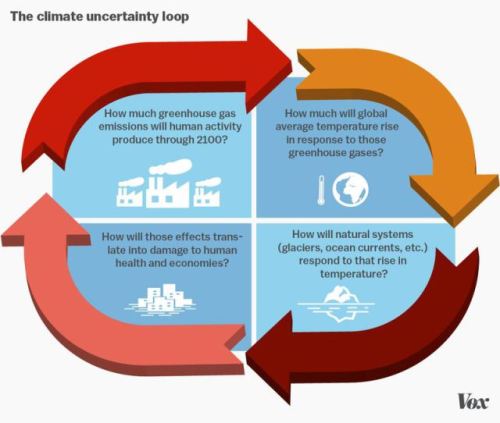

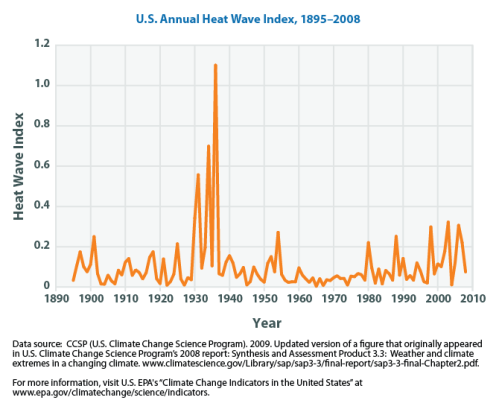
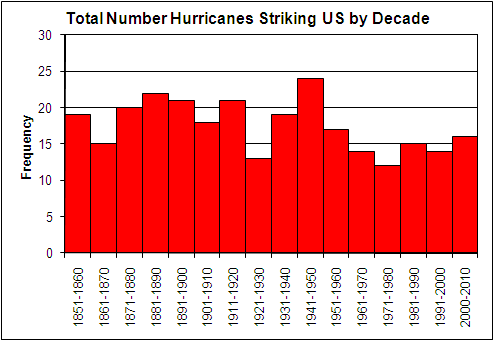
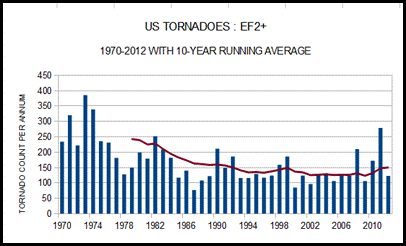
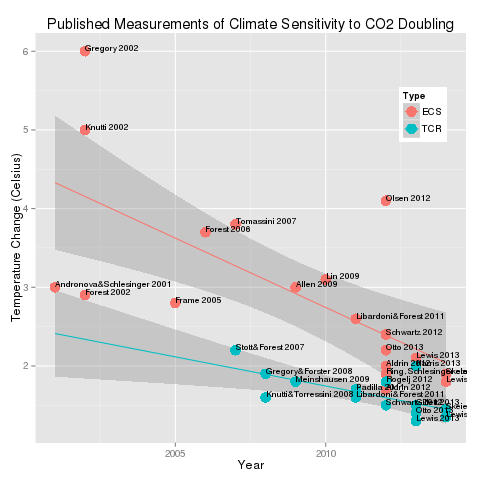
Tom, Tobis is simply confident to admit that it was never about rational thought, ethical behavior or science. We should be proud that his now, finally, brave enough to admit it is simply about his hysterical non-fact based hysterical fear. He never did care if there were any facts to back him up. He does not care if there is an actual risk. His beliefs in his mission are immune to data. It is rare that a fanatic kook grows a pair and will simply lay it out plainly. Tobis is that rare kook. Mark the calendar.
I actually like the fact that MT and ATTP are recognizing policy realities as the 800 pound gorilla. It seems to me that in the past they were arguing that “the physics” was so conclusive we could “easily” adopt significant internationally binding responses to CAGW. Obviously, it hasn’t turned out so easy after all. At least we’ll always have Paris … https://www.youtube.com/watch?v=pa-dGYjSq5k
Of course, calculating a “damage per unit of carbon emitted” means you have to accurately estimate BOTH climate sensitivity and economic impact. But if they reject the major models for doing either, they are left with doing neither.
Climatologists lack training and experience needed to study and analyze strategy options properly. But they do seem to handle selfpromotion and pushing the envelope into areas they know almost nothing about.
I did notice Curry trying to enter a realm that’s beyond climatology, but she’s still learning the basics. What’s needed is an integrated effort by a very diverse group of individuals. Given the extremely poor training at the top (Obama, Murkel, etc) humanity is about to blunder wasting huge sums.
The obvious answer is to focus on technology development (including geoengineering) using pilots and demonstration projects, start rolling with a low level carbon fee, and be ready for a flexible response to events.
Fernando,
The ignorance at the top is *manifesting* as climate madness. Climate madness is but one small manifestation of the failure by our leaders.
If we are very lucky the foolish wasteful policies clustered around climate will be the worst manifestation of this failure. The poor analytical skills that it takes to sustain something as transparently stupid as the “climate change” policies in placed and envisioned by so many will inevitably lead to much worse errors of judgement and character.
Tom,
Is the last graph observational estimates only, excluding model estimates? It looks it.
Hi Mike, I think the bottom right hand portion is dominated by observational estimates. Most of the earlier stuff is model only.
Since 2010 nearly all papers published suggest a TCR of less than 2 degC.
IF (and this is only an IF) the current El Nino does not result in a step change in temperatures as was seen following the 1997/8 Super El Nino (which created an about 0.25degC step change), then it is likely that a La Nina that follows in say 2017 will cancel out the temporary warming blip caused by the current strong El Nino. This will mean that by 2018 the satellite temperature anomaly will be tracking at around the 201 to 2003 level, the result of which will be that the ‘pause’ (as seen in the satellite data set) will be about 21 years in duration by the time that AR6 is being worked on and published.
The consequences of this are obvious. As the pause extends in duration there will be more and more papers published showing ever lessening figures for TCR (and ECS). In this scenario, more than 36% of all manmade emissions will have been emitted with no corresponding rise in temperature, such that we can expect to see several more papers putting TCR below 1.5egC.
In AR5, the IPCC largely ignored the then recent papers on TCR which were few in number, and some published around the closing date for consideration. That will not apply to AR6.
This is a problem for the IPCC. AR6 will (in the scenario detailed above) have to deal with 8 or 9 years worth of papers nearly everyone of which putting TCR at less than 2, and with many putting TCR at less than 1.5.
Already in AR5 no consensus with respect to TCR could be expressed, and the problem can only get worse since the latest info will strongly suggest a TCR of less than 2 which the IPCC will not wish to publish.
Further, on the scenario set out above, all the models will be outside their 95% confidence level, and the IPCC will be obliged to acknowledge that all the projections were warm, and that future warming is projected to be lower than previously suggested.
I foresee a great many difficulties for the IPCC and AR6 if the current El Nino does not result in a step change in temperatures such as to bust the ‘pause’ which is seen in the satellite data set. If the ‘pause’ is still evident in late 2018/early 2019, it will be interesting to see how the IPCC side steps the issue of ever lowering Climate Sensitivity.
Of course if Paris 2015 could result in a truly binding and worthwhile agreement, then perhaps AR6 could be ditched altogether, but an onerous binding agreement looks extremely unlikely given the attitude of China. India and Russia.
Richard,
The climate obsessed are implicitly recognizing this. Their response is to double up on the hype and bullshit. And to further dismiss any pretense of science, deny the pause and claim the discussion is over.
Look at the latest bloviation by Tobis, as a small example. If he was actually concerned about he climate, he would modify his stance based on new data. That is called “rational behavior”. Instead he comes up with rationalizations to ignore the evidence he does not like and to demand his infantile policy demands be implemented more quickly.
That sort of nonsense permeates the climate obsessed community all the way to the White House.
Others may be accused of shifting goalposts, but I am innocent of the charge.
The ECS is probably between 2.5 and 3, where it has always been. The TCR is ill-defined, as it has always been. Global warming is not the key socially relevant metric of climate disruption, as I said before anyone was talking about the hiatus and as I still say now that the hiatus is apparently ending.
Changing the radiative properties of the atmosphere to a larger extent than the Milankovic forcing will cause substantial climate change.
The changed climate will almost certainly be substantially warmer, whence all the obsession on global mean surface temperature, which is after all relatively easy to measure. But the warmed global climate is not the cause of climate change – it is a consequence of climate change.
The main issue that people will have to deal with is not this global measure, but that this measure is the result of climate changing locally everywhere in ways that are hard to predict and hard to manage. The extent of change can already be expected to be comparable in magnitude to the Milakovic cycle changes but much faster, leaving local adaptations, both artificial and natural, stressed and at risk of decline. The longer we delay in reaching carbon neutrality, the larger the disruption we have committed to.
Nothing in the recent observational data calls any of this into question in the least.
The process is slow on political time scales. Talk about what will happen to GMST in 2017 is a fine example of missing the point. People may be silly enough that this will affect politics. But the climate system won’t care a bit.
The response of the climate system is dominated by how much fossil carbon gets emitted from the beginning of the industrial revolution until the day we reach carbon neutrality. The rest is secondary.
Many bold assertions. Some of the boldest have the least evidence behind them, including about the sensitivity that all of a sudden you wish to leave out of the discussions. Neither you nor any member of your tribe have shown that a) current climate change is primarily caused by human emissions of CO2 or b) that the result will be similar to that caused by Milankovitch cycles.
I well remember what you have said in the past. One reason your bold assertions are not taken at face value is that I remember what you have said in the past.
If you had written about this clearly and consistently it might have led to an intelligent debate on the proposition. Instead you shit all over your opponents and generally acted like a 3-year old child–and not a nice 3-year old child.
It wasn’t skeptics or lukewarmers who spent a decade spouting off about the presumed trajectory of GMST. It wasn’t skeptics who insisted that sensitivity was high and that therefore we needed to take action.
But before studies appeared showing that both ECR and TCS were in fact far lower than what your scenarios demanded you did not utter a word in print about their dis-utility.
You wasted more than a decade lying about Steve Mosher and myself, smearing Judith Curry and defending the indefensible from others in your tawdry little tribe.
You will recall that at your place of public business I repeatedly wrote that you didn’t write about climate science–that all you did was kvetch about how unfair and evile skeptics were.
Now, finally, in the waning days of 2015 you want to talk about the science of human contributions to climate change. Fine. You have a credibility gap a mile wide to overcome due to your past behavior, at least with me.
So shut up and get to work.
Tom,
You advice to MT, “So shut up and get to work” is great in the first part. As to the second, he is only in it for the gold- he has been working like a busy bee spreading his climate bullshit for fun and profit for quite awhile.
The chances of him leaving behind his cynical fear mongering are asymptotically approaching zero. Climate fear is a major lucrative worldwide industry. MT may be a bit player, but he plays it with gusto.
MT,
“The ECS is probably between 2.5 and 3, where it has always been”. Followed up by the gob smackingly delusional, “Nothing in the recent observational data calls any of this into question in the least.” So you really are immune to data. Thanks for clearing that up. You are no different than a failed prophet who keeps claiming that the second coming is right around the corner.
And by the way, if temps don’t rise nothing else much can happen either except in the fervent delusions of the climate kooks.
Pingback: ‘Bygones.’ Forgetting the Climate Past, Reinventing the Climate Future | The Lukewarmer's Way
I believe it is incontrovertible that the whole AGW debate and the actions that should be taken concerning it revolves around the increase in temperature caused by a doubling in the concentration of atmospheric carbon dioxide – commonly referred to as climate sensitivity, and that over the past three decades many billions of dollars have been expended researching this extremely important value. A low value indicates that we have little or nothing to fear from a doubling of atmospheric carbon dioxide, a high value indicates that we may have a serious problem.
I doubt anyone on either side of the debate can disagree that this is a very important issue.
So let us see how much progress has been made over the last couple of decades pinning down this extremely important number.
The IPCC is commonly regarded as the most reputable authority on such matters, so let us see how estimates of the climate sensitivity have changed over the five IPCC Assessment Reports from 1990 to the present day, a period of some two and a half decades.
Here are the ranges of value given by the five IPCC Assessment Reports that have been published to date.
So, despite the expenditure of many billions of dollars on research,
computer gamesclimate models etc., estimates of the low and high limits of this essential parameter have not changed in 25 years.In fact, it is worse than that, the original 1.5- 4.5°C estimate came from the Charney report 36 years ago in 1979.
Click to access charney_report.pdf